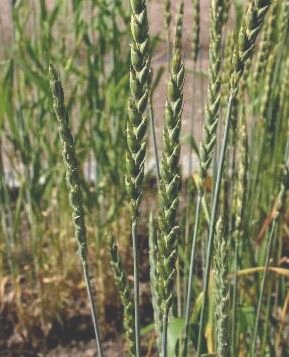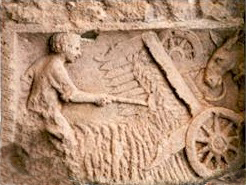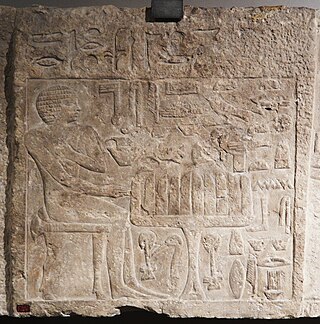Related Research Articles

A cereal is any grass cultivated for the edible components of its grain, which is composed of an endosperm, a germ, and a bran. Cereal grain crops are grown in greater quantities and provide more food energy worldwide than any other type of crop and are therefore staple crops. They include wheat, rye, oats, and barley. Edible grains from other plant families, such as buckwheat, quinoa and chia, are referred to as pseudocereals.

Pasta is a type of food typically made from an unleavened dough of wheat flour mixed with water or eggs, and formed into sheets or other shapes, then cooked by boiling or baking. Rice flour, or legumes such as beans or lentils, are sometimes used in place of wheat flour to yield a different taste and texture, or as a gluten-free alternative. Pasta is a staple food of Italian cuisine.

Bread is a staple food prepared from a dough of flour and water, usually by baking. Throughout recorded history and around the world, it has been an important part of many cultures' diet. It is one of the oldest human-made foods, having been of significance since the dawn of agriculture, and plays an essential role in both religious rituals and secular culture.

Flour is a powder made by grinding raw grains, roots, beans, nuts, or seeds. Flours are used to make many different foods. Cereal flour, particularly wheat flour, is the main ingredient of bread, which is a staple food for many cultures. Corn flour has been important in Mesoamerican cuisine since ancient times and remains a staple in the Americas. Rye flour is a constituent of bread in central and northern Europe.

Pita or pitta, is a family of yeast-leavened round flatbreads baked from wheat flour, common in the Mediterranean, Middle East, and neighboring areas. It includes the widely known version with an interior pocket, also known as Arabic bread. In the United Kingdom, Greek bread is used for pocket versions such as the Greek pita, and are used for barbecues to a souvlaki wrap. The Western name pita may sometimes be used to refer to various other types of flatbreads that have different names in their local languages, such as numerous styles of Arab khubz (bread).

Emmer wheat or hulled wheat is a type of awned wheat. Emmer is a tetraploid. The domesticated types are Triticum turgidum subsp. dicoccum and Triticum turgidum conv. durum. The wild plant is called Triticum turgidum subsp. dicoccoides. The principal difference between the wild and the domestic is that the ripened seed head of the wild plant shatters and scatters the seed onto the ground, while in the domesticated emmer the seed head remains intact, thus making it easier for humans to harvest the grain.

Spelt, also known as dinkel wheat or hulled wheat, is a species of wheat that has been cultivated since approximately 5000 BC.

Roman agriculture describes the farming practices of ancient Rome, during a period of over 1000 years. From humble beginnings, the Roman Republic and the Roman Empire expanded to rule much of Europe, northern Africa, and the Middle East and thus comprised many agricultural environments of which the Mediterranean climate of dry, hot summers and cool, rainy winter was the most common. Within the Mediterranean area, a triad of crops were most important: grains, olives, and grapes.

A flatbread is a bread made with flour; water, milk, yogurt, or other liquid; and salt, and then thoroughly rolled into flattened dough. Many flatbreads are unleavened, although some are leavened, such as pizza and pita bread.

Farro refers to the grains of three wheat species, which are sold dried and cooked in water until soft. It is eaten plain or is often used as an ingredient in salads, soups, and other dishes.
Ancient Greek cuisine was characterized by its frugality for most, reflecting agricultural hardship, but a great diversity of ingredients was known, and wealthy Greeks were known to celebrate with elaborate meals and feasts.
Armenian cuisine includes the foods and cooking techniques of the Armenian people and traditional Armenian foods and dishes. The cuisine reflects the history and geography where Armenians have lived as well as sharing outside influences from European and Levantine cuisines. The cuisine also reflects the traditional crops and animals grown and raised in Armenian-populated areas.

Sprouted bread is a type of bread made from whole grains that have been allowed to sprout, that is, to germinate, before being milled into flour. There are a few different types of sprouted grain bread. Some are made with additional added flour, some are made with added gluten, and some, such as Essene bread and Ezekiel bread, are made with very few additional ingredients.

Kūčiukai also called Christmas cakes - is a traditional Lithuanian dish served on Kūčios, the traditional Christmas Eve dinner in Lithuania. They are small, slightly sweet pastries made from leavened dough and poppy seeds. There are variations in sweetness, it is usually eaten dry but can be served soaked in poppy milk or with cranberry kissel. Initially they were made as small loaves of bread served for the spirits - vėlės.
Murrī or almorí was a type of fermented condiment made with barley flour, known from Maghrebi and Arab cuisines. Almost every substantial dish in medieval Arab cuisine used murrī in small quantities. It could be used as a substitute for salt or sumac, and has been compared to soy sauce by Rudolf Grewe, Charles Perry, and others due to its high glutamates content and resultant umami flavor.

Bread was central to the formation of early human societies. From the Fertile Crescent, where wheat was domesticated, cultivation spread north and west, to Europe and North Africa, and east towards East Asia. This in turn led to the formation of towns, as opposed to the nomadic lifestyle and gave rise to more and more sophisticated forms of societal organization. Similar developments occurred in the Americas with maize and in Asia with rice.
Zythum, sometimes also known as zythus or zythos was a malt beer made in ancient Egypt. The earliest existing records of brewing relate to the production of zythum by ancient Egyptians, circa 2000 BCE.

Paximathia, also spelt paximadia (plural), or paximadi/paximathi (singular), is a hard bread of Greek origin, similar to rusk, that is prepared with whole wheat, chick pea or barley flour. It has been referred to as being similar to biscotti or as a type of biscotti. Paximathia is a common food in Greece and many Greek bakeries sell the bread, which is often served as a breakfast food with marmalade or cheese. Paximathia is purveyed also in Greek specialty stores in many areas of the United States.
Peter Reinhart is an American baker, educator and author. He is most known for writing Bread Revolution, American Pie: My Search for the Perfect Pizza, The Joy of Gluten-Free, Sugar-Free Baking and The Bread Baker’s Apprentice. Four of his books have been nominated for James Beard Awards, with three of them winning, including the "Book of the Year" in 2002 for The Bread Baker's Apprentice.

Ancient grains is a marketing term used to describe a category of grains and pseudocereals that are purported to have been minimally changed by selective breeding over recent millennia, as opposed to more widespread cereals such as corn, rice and modern varieties of wheat, which are the product of thousands of years of selective breeding. Ancient grains are often marketed as being more nutritious than modern grains, though their health benefits over modern varieties have been disputed by some nutritionists.
References
- 1 2 3 4 5 "Zea, Greece's Comeback Grain". Culinarybackstreets. 2016-03-15. Retrieved 2019-12-01.
- 1 2 3 4 5 "Zea's Revival". Greece Is. 2017-01-09. Retrieved 2019-12-01.
- ↑ Sakellis, Eleni (2018-11-24). "Baking with Zea Flour, Our Favorite Recipes for Thanksgiving". The National Herald. Retrieved 2019-12-01.[ permanent dead link ]
- ↑ Sakellis, Eleni (2019-07-16). "Greek Beer: From Antiquity to Modern Microbrews". The National Herald. Archived from the original on 2019-07-16. Retrieved 2019-12-01.